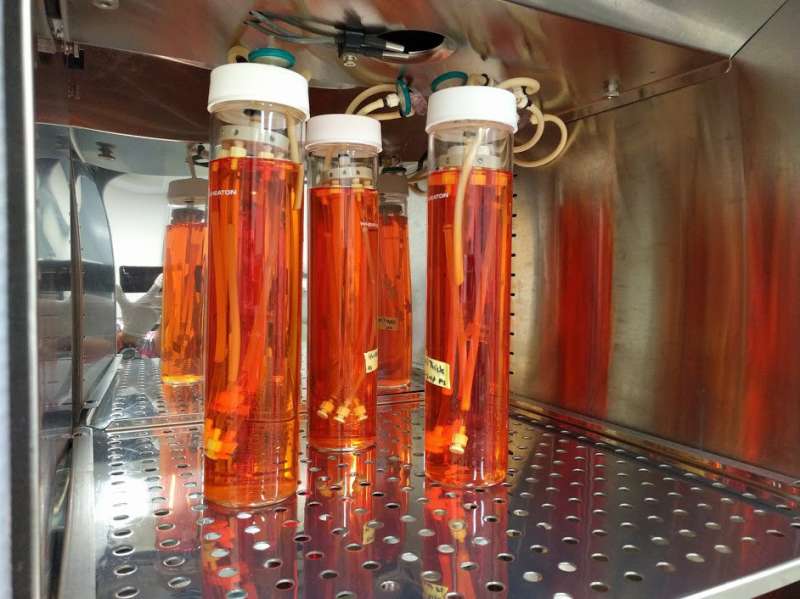New tissue-engineered blood vessel replacements one step closer to human trials

Researchers at the University of Minnesota have created a new lab-grown blood vessel replacement that is composed completely of biological materials, but surprisingly doesn't contain any living cells at implantation. The vessel, that could be used as an "off the shelf" graft for kidney dialysis patients, performed well in a recent study with nonhuman primates.
It is the first-of-its-kind nonsynthetic, decellularized graft that becomes repopulated with cells by the recipient's own cells when implanted. The discovery could help tens of thousands of kidney dialysis patients each year. The grafts could also be adapted in the future for use as coronary and peripheral bybass blood vessels and tubular heart valves.
The research was published today as the cover story in Science Translational Medicine. The University of Minnesota has also licensed the technology.
More than 100,000 people in the United States begin hemodialysis each year to treat kidney disease and more than 400,000 people are being treated with life-saving hemodialysis nationwide, according to the U.S. Renal Data System Annual Data Report. An arteriovenous fistula, which connects an artery to a vein in the arm, is currently the preferred mode of blood vessel access for hemodialysis. However, 30-50 percent of patients experience complications and need to connect the vein and artery using an artificial tube, called an arteriovenous graft.
Currently, these artificial grafts are made of synthetic materials that are prone to clotting, infection and other complications. Grafts grown in the lab from cells and biological materials could cause fewer adverse reactions, but living tissues aren't stable for long-term storage and could induce an immune response unless the patient's own cells were used, both being barriers to commercialization and clinical use.
In this pre-clinical study, University of Minnesota researchers generated vessel-like tubes in the lab from post-natal human skin cells that were embedded in a gel-like material made of cow fibrin, a protein involved in blood clotting. Researchers put the cell-populated gel in a bioreactor and grew the tube for seven weeks and then washed away the cells over the final week. What remained was the collagen and other proteins secreted by the cells, making an all-natural, but non-living tube for implantation.
"We harnessed the body's normal wound-healing system in this process by starting with skin cells in a fibrin gel, which is Nature's starting point for healing," said University of Minnesota Department of Biomedical Engineering Professor Robert Tranquillo who led the study. "Washing away the cells in the final step reduces the chance of rejection. This also means the vessels can be stored and implanted when they are needed because they are no longer a living material. In the future, thousands of the lab-grown vessels could be made from a small skin biopsy from one donor and then stored on the shelf for when they are needed by patients."
To test the vessels, the researchers implanted the 15-centimeter-long (about 5 inches) lab-grown grafts into adult baboons donated by Mayo Clinic as it was closing down its primate facility. Six months after implantation, the grafts grossly appeared like a blood vessel and the researchers observed healthy cells from the recipients taking up residence within the walls of the tubes. None of the grafts calcified and only one ruptured, which was attributed to inadvertent mechanical damage with handling. The grafts after six months were shown to withstand almost 30 times the average human blood pressure without bursting. The implants showed no immune response and resisted infection. In addition, the grafts withstood repeated needle punctures by self-healing, which would be a necessary process for patients undergoing long-term dialysis.
"This pre-clinical trial was extremely important to us," Tranquillo said. "In previous studies, we implanted vessels in sheep, but we needed to test them in a more human-like model before risking human lives because the success of our material depends on the ability of the recipient to recellularize it into a living tissue without immune response, which might have failed in a human even though it succeeded in a sheep."
With the success of this study, Tranquillo and the team will seek FDA approval for clinical trials in children with pediatric heart defects since they recently reported a study in Nature Communications that this material is also capable of growing.
More information: Z.H. Syedain el al., "A completely biological 'off-the-shelf' arteriovenous graft that recellularizes in baboons," Science Translational Medicine (2017). stm.sciencemag.org/lookup/doi/ … scitranslmed.aan4209


















